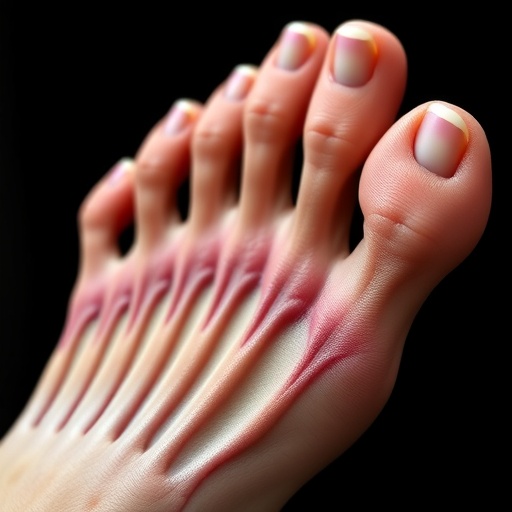In a significant advancement within dermatological research, leading experts in the field have provided a comprehensive response to a letter regarding the adherence and persistence of biologic treatments in patients suffering from palmoplantar pustulosis (PPP). This condition, often characterized by painful pustules on the palms and soles, presents both physical challenges and psychological burdens for the affected individuals. While biologic treatments have revolutionized the management of several chronic inflammatory skin disorders, questions regarding patient adherence and the long-term sustainability of these treatments remain critically important.
In their response, Tognaccini, Thomas, and Ghanim, along with their colleagues, meticulously evaluated a real-world claims-based study that sought to shed light on how effectively patients with PPP adhere to prescribed biologic therapies. The study’s findings reveal pertinent insights into the patterns of treatment persistence, shedding light on the ongoing challenges faced by healthcare providers in managing this complex disease. The authors emphasized the necessity of understanding treatment adherence not merely as a statistic but as a critical factor that directly influences patient outcomes and overall quality of life.
One of the most striking aspects of the study is its exploration of the barriers that contribute to non-adherence among patients undergoing biologic therapy. Various factors, including side effects, healthcare access issues, and the psychological impact of chronic illness, were identified as significant contributors to inconsistent treatment. The authors argue that a detailed understanding of these barriers is essential for developing targeted interventions that can substantially improve adherence rates and, subsequently, patient outcomes.
Within the spectrum of potential solutions, the authors advocate for a multifaceted approach. A combination of patient education, enhanced communication between healthcare providers and patients, and the integration of support systems can be beneficial. By fostering a shared decision-making environment and addressing the patients’ concerns, healthcare providers can encourage sustained adherence to biologic therapies. The importance of regular follow-up and feedback was particularly highlighted; by monitoring patients’ experiences and addressing their concerns proactively, clinicians can mitigate some of the frustrations that lead to discontinuation of treatment.
Moreover, the study emphasizes the role of patient-centered care in the treatment of PPP. Engaging patients in their treatment plans empowers them, making it more likely that they will remain committed to their therapy. This collaboration between healthcare providers and patients lays the groundwork for a more personalized approach to treatment, acknowledging the individual patient’s journey rather than relying on a one-size-fits-all methodology. The authors contend that such collaboration can lead to improved disease management and adherence in the long run.
Technological advancements also play a vital role in improving treatment adherence among PPP patients. The proliferation of digital health platforms offers new avenues for communication and support. Through telemedicine, patients can more easily access healthcare professionals, share their concerns, and receive timely advice on managing their condition. Furthermore, mobile apps designed specifically for chronic illness management can remind patients to take their medications, track their symptoms, and even connect with peer support networks. These innovations can serve to bridge the gap for those who may feel isolated in their treatment journeys, enhancing their overall experience and encouraging adherence.
Additionally, the authors discuss the implications of socioeconomic factors on treatment adherence. The study revealed that patients from lower socioeconomic backgrounds often faced greater challenges in adhering to biologic treatments. Barriers such as cost, lack of insurance, and inadequate access to healthcare services can greatly hinder a patient’s ability to maintain their prescribed treatment regimen. Thus, addressing these social determinants of health is is crucial to ensuring equitable access to treatment for all patients suffering from PPP.
Importantly, the authors call for more robust data collection and analysis in future studies concerning biologic treatment adherence. The insights gleaned from longitudinal studies can illuminate trends and outcomes, guiding both clinical practice and policy decisions. As the healthcare landscape continues to evolve, it remains critical that researchers and providers work together to fill these knowledge gaps, ultimately fostering a deeper understanding of how to optimize treatment for chronic inflammatory skin diseases.
Furthermore, the rapidly growing body of literature on biologic treatments for PPP emphasizes the need to continually re-evaluate existing frameworks for treatment protocols. The landscape of dermatological therapies is ever-changing, with new agents and treatment strategies emerging at a swift pace. Therefore, ongoing education and training for healthcare providers are imperative to ensure that they remain well-informed about the latest developments, enabling them to provide the best possible care for their patients.
In summary, the response by Tognaccini, Thomas, Ghanim, and their colleagues serves as a clarion call for the medical community to pay heed to the challenges of treatment adherence in patients with palmoplantar pustulosis. By integrating patient feedback, addressing social determinants of health, leveraging technology, and fostering a collaborative treatment environment, it is possible to enhance adherence rates and improve patient outcomes. As the field continues its trajectory toward personalized medicine, the commitment to understanding and improving biologic treatment adherence will remain central to patient-centered care in dermatology.
The implications of this research extend beyond the realm of dermatology, reaching into broader discussions about chronic disease management, health equity, and the future of patient care. As healthcare approaches evolve, the lessons learned from the experiences of PPP patients can provide valuable insights for other areas where adherence to treatment remains a significant challenge.
What is clear is that the pursuit of better treatment adherence is not merely an academic exercise but a necessary endeavor that can significantly enhance the lives of patients grappling with chronic conditions. The proactive engagement of the healthcare community in addressing these challenges underscores a collective responsibility toward improving not only adherence but also the holistic wellbeing of patients.
As we move toward a future informed by research and innovation, the findings from this important study will undoubtedly help shape clinical methodologies and patient interactions. In recognizing the intricacies involved in treatment adherence, the healthcare field can take significant strides toward fostering improved outcomes for individuals suffering from complex and often debilitating conditions such as palmoplantar pustulosis.
In conclusion, the response from these leading experts in the field articulates a pivotal moment in the discussion surrounding treatment adherence in chronic inflammatory conditions. It urges both the clinical community and patients to consider the multifaceted nature of adherence, prompting a collaborative approach focused on enhancing patient engagement and treatment outcomes alike. The path forward is one that necessitates commitment, innovation, and above all, a patient-centered mindset that prioritizes the unique journeys of those living with chronic illness.
Subject of Research: Biologic Treatment Adherence and Persistence in Patients with Palmoplantar Pustulosis
Article Title: Response to Letter Regarding: “Biologic Treatment Adherence and Persistence in Patients with Palmoplantar Pustulosis: A Real-World, Claims-Based Study”
Article References:
Tognaccini, C., Thomas, L.E., Ghanim, D. et al. Response to Letter Regarding: “Biologic Treatment Adherence and Persistence in Patients with Palmoplantar Pustulosis: A Real-World, Claims-Based Study”.
Adv Ther (2025). https://doi.org/10.1007/s12325-025-03405-2
Image Credits: AI Generated
DOI:
Keywords: Treatment adherence, palmoplantar pustulosis, biologic therapies, chronic disease management, patient-centered care, digital health.
Tags: barriers to adherence in biologic therapybiologic treatments for palmoplantar pustulosischallenges in managing palmoplantar pustulosisdermatological research advancementsfactors affecting treatment adherencehealthcare provider strategies for PPP managementpatient adherence to biologic therapiespersistence of biologic treatmentspsychological impact of palmoplantar pustulosisquality of life in skin disordersreal-world claims-based study on PPPtreatment patterns in dermatology





